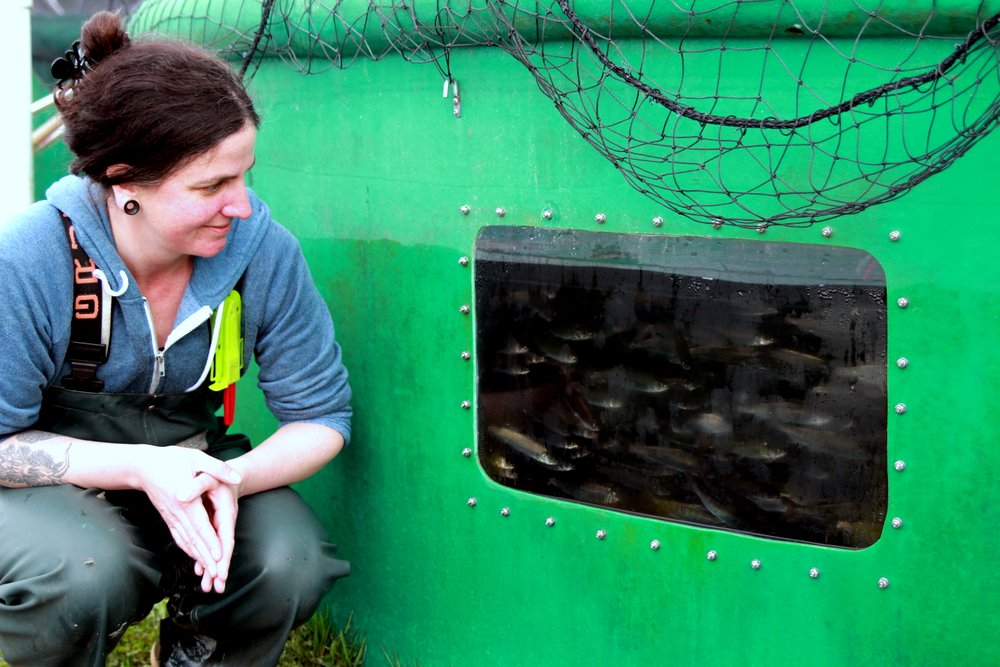
SSSC aquaculture director Angie Bowers examines the 14,000 coho smolt who survived near-suffocation Saturday (5-5-18). Although not a disaster for the hatchery, “this was intentional.” Located in downtown Sitka on the historic Sheldon Jackson Campus, the center is considering installing surveillance cameras. (KCAW photo/Robert Woolsey)
Some minor vandalism at a downtown Sitka fish hatchery over the weekend created major trauma for some juvenile coho salmon.
The Sitka Sound Science Center reports losing 1,000 coho smolt in the incident, just days before they were to be released into the ocean.
At the Sitka Sound Science Center hatchery…
Everything looks like business as usual at the Sitka Sound Science Center hatchery. Aquaculture program manager Angie Bowers and two techs are transferring around 159,000 coho smolt from several large green tanks — called ponds — into saltwater holding pens in Sitka Sound.
They’ll rear there for about another 3 weeks, learn the scent of the hatchery’s outfall stream, and then be released for their 18-month journey into the ocean.
This release would have been 160,000 smolt, except someone entered the hatchery grounds late Friday (5-4-18) night and turned off the fresh water valve supplying one of the ponds.
KCAW – Which means they were not getting oxygen?
Bowers – Right. There was no flow. No water coming in. So the level was down and fish were belly-up. She turned the water back on, and a lot came back. But we lost about a thousand, out of 15,000.

Hatchery tech Brian LeBlanc releases coho smolt into a siphoning system that transports them to saltwater net pens in Sitka Sound. It takes the hatchery almost 2 years to rear coho to this size (24 grams, 4-5 inches in length). Chum and pink salmon, on the other hand, are released into the ocean as fry weighing about 2 grams each. (KCAW photo/Robert Woolsey)
The vandalism was discovered by the hatchery intern, Maria Savolainen, and reported to Sitka police.
So 1,000 juvenile salmon — no big deal, right? Wild coho, or silver salmon, spend over a year in freshwater after they’ve hatched, before entering the ocean. For a hatchery, growing coho to this size — about 24 grams in weight — is a big deal.
These fish were hatched here in the spring of 2016.
Bowers – So they spend that first whole winter up until April in incubation, and they come out as little more than a quarter-gram.
KCAW – They look like they’re 4 or 5 inches long now?
Bowers – Yep.
Bowers is the first to admit that this is not a huge tragedy. It’s fortunate that Savoleinen came in on Saturday to feed the smolt, or the tank may have drained entirely, and killed all 15,000 silvers. Although ocean survival is impossible to predict, Bowers estimates that if only 8-percent of the lost coho had survived to return in 2019, they would have been worth roughly $1,100 to commercial fishermen.
This vandalism wasn’t a spree. Nothing else at the Science Center was damaged. But it was deliberate.
“And it’s not an easy thing to do,” she says. “Like, it’s not something that you could just bump and have happen. It would have to be intentional. So we have talked about getting security cameras now. I think that’s probably something we’ll do.”
Bowers says it’s taken a while to rebuild the hatchery’s coho program, after a blocked intake upstream in the Indian River in 2010 killed off an entire age class of rearing salmon, leaving an every-other-year gap in production. Techs collected coho eggs from the river itself to restart coho.
“After this year,” says Bowers, “we should be back on track.”
Note: Angie Bowers is a long-time programming volunteer at KCAW, who now serves on the station’s board of directors.






























